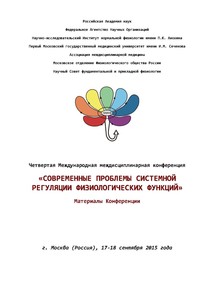AMYLOID SPECIES, NEUROCHEMISTRY AND AUTOIMMUNITY LINKED TO PARKINSONIAN-LIKE SYMPTOMS
Бесплатно
Основная коллекция

Издательство:
НИИ ноpмальной физиологии им. П.К. Анохина
Год издания: 2015
Кол-во страниц: 2
Дополнительно
ББК:
УДК:
ГРНТИ:
Скопировать запись
Фрагмент текстового слоя документа размещен для индексирующих роботов
for each cannabinoid receptor or for the proteins involved in endocannabinoids inactivation. The generation of genetically modified mice with selective mutations in these endocannabinoid system components has now provided important advances in establishing their specific contribution to drug addiction. These genetic tools have identified the particular interest of CB1 cannabinoid receptor and endogenous anandamide as potential targets for drug addiction treatment. Novel genetic tools will allow determining if the modulation of CB2 cannabinoid receptor activity and 2-arachidonoylglycerol tone can also have an important therapeutic relevance for drug addiction.
References
1. Flores A, Maldonado R, Berrendero F. The hypocretin/orexin receptor 1 as a novel target to modulate cannabinoid reward. Biol Psychiatry.
2014 Mar 15;75(6):499-507. doi: 10.1016/j.biopsych.2013.06.012. Epub 2013 Jul 26.
2. Flores A, Maldonado R, Berrendero F. Cannabinoid-hypocretin crosstalk in the central nervous system: what we know so far. Front Neurosci. 2013 Dec 20;7:256. doi: 10.3389/fnins.2013.00256.
3. Maldonado R1, Robledo P, Berrendero F. Endocannabinoid system and drug addiction: new insights from mutant mice approaches. Curr Opin Neurobiol. 2013 Aug;23(4):480-6. doi: 10.1016/j.conb.2013.02.004.
Epub 2013 Mar 13.
4. Maldonado R, Berrendero F, Ozaita A, Robledo P. Neurochemical basis
of cannabis addiction. Neuroscience. 2011 May 5;181:1-17.
5. Maldonado R, Berrendero F. Endogenous cannabinoid and opioid systems
and their role in nicotine addiction. Curr Drug Targets. 2010 Apr;11(4):440-9. Review.
DOI:10.12737/12271
AMYLOID SPECIES, NEUROCHEMISTRY AND AUTOIMMUNITY LINKED TO PARKINSONIAN-LIKE SYMPTOMS
R. D. E. Sewell¹, M. A. Gruden²
¹Cardiff School of Pharmacy & Pharmaceutical Sciences, Cardiff University, Cardiff, CF10 3NU., UK,
²P. K. Anokhin Research Institute of Normal Physiology, Moscow, 125009, Russia
Parkinson’s disease (PD) is a neurodegenerative disorder in which a-synuclein (a-syn) toxic aggregates specifically from the synuclein protein family and neurotransmitters such as dopamine (DA) play a critical role. a-Syn itself is known to be natively unstructured but it is in equilibrium with subpopulations of more compact structures and it is these aggregates that are thought to be linked to amyloid formation. In this respect, there are elevated autoantibody serum titers to a-synuclein monomers, oligomers and fibrils which appear to reach a zenith in Parkinsonian patients at the 5-year disease stage (Gruden et al., 2011). We have also demonstrated that in vitro, a-syn can form
18
alternative, non-native amyloid self-assemblies including amyloid oligomers and fibrils which may be delivered in vivo by the nasal vector (Gruden et al., 2013).
Accordingly, synthetically generated toxic oligomers or fibrils were administered intranasally to mice for 14 days and “open-field” behavior was subsequently tested on days 0 and 14 days after treatment completion. Behavioral deficits at the end of the dosing regime and 14 days later included rigidity, hypokinesia and immobility. This was accompanied by elevated DA, DOPAC and HVA concentrations only in the substantia nigra (SN) in response to dual administration of a-syn oligomers plus fibrils but not the oligomers by themselves. a-Syn fibrils intensified not only the hypokinesia and immobility 14 days post treatment, but also reduced vertical rearing and enhanced DA levels in the SN. Only nigral DA turnover (DOPAC/DA) but not HVA/DA ratios were augmented in response to fibril treatment but there were no changes in the striatum. The a-syn oligomer/fibril mixture instigated PD-like motor symptoms which also correlated heterochronically with elevated NA levels in the striatum but then later in the SN intranasal fibrils alone augmented 5-HT and 5-HIAA nigral concentrations in the protocol (Gruden et al., 2015). In contrast, a-syn oligomers displayed a delayed serotonin upsurge in the SN. Amyloid seeding plus neurodegenerative apoptotic pores as well as actions on neurotransmitter synthesis and/or transporters (such as NET, SERT and VMAT2) are potentially implicated in these a-syn amyloid induced neurochemical and motoric disturbances. In addition, activation of the immune system towards misfolded a-syn species and dopamine occurred during the experimental protocol in the mice. Compilation of these novel behavioral, immunological and neurochemical findings substantiate the validity of the a-syn nasal vector model for investigating parkinsonian-like symptoms.
References
1. Gruden MA, Sewell RDE, Yanamandra, K, Davidova TV, Kucheryanu, VG, Bocharov EV, Bocharova OR, Polyschuk VV, Sherstnev VV, Morozova-Roche LA. Immunoprotection against toxic biomarkers is retained during Parkinson's disease progression. J Neuroimmunol. 2011;233:221-227.
2. Gruden M A, Davidova T V, Yanamandra K, Kucheryanu V G, Morozova-Roche LA, Sherstnev VV, Sewell RDE. Nasal inoculation with a-synuclein aggregates evokes rigidity, locomotor deficits and immunity to such misfolded species as well as dopamine. Behav Brain Res. 2013;243:205-12.
3. Gruden MA, Davydova TV, Narkevich VB, Fomina VG, Wang C, Kudrin VS, Morozova-Roche LA, Sewell RD. Noradrenergic and serotonergic neurochemistry arising from intranasal inoculation with a-synuclein aggregates which incite parkinsonian-like symptoms. Behav Brain Res. 2015 Feb 15;279:191-201. doi: 10.1016/j.bbr.2014.11.001.
DOI:10.12737/12272
СЕРОТОНИНЕРГИЧЕСКИЕ НЕРВЫ И ПОДТИПЫ ИХ РЕЦЕПТОРОВ
Смирнов В.М., Свешников Д.С., Мясников И.Л., Кучук А.В.
Российский университет дружбы народов, Москва
19

